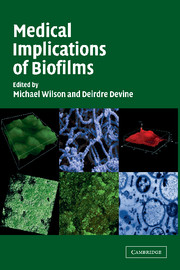Book contents
- Frontmatter
- Contents
- Preface
- List of Contributors
- PART ONE INTRODUCTORY CHAPTERS
- PART TWO BIOFILMS ON PROSTHETIC DEVICES
- 4 Animal Models of Orthopaedic Implant Infection
- 5 Intravascular-Catheter-Related Infections
- 6 Molecular Basis of Biofilm Formation by Staphylococcus epidermidis
- 7 Biofilm Complications of Urinary Tract Devices
- PART THREE ORAL BIOFILMS
- PART FOUR BIOFILMS ON SHEDDING SURFACES
- Index
- References
6 - Molecular Basis of Biofilm Formation by Staphylococcus epidermidis
Published online by Cambridge University Press: 23 November 2009
- Frontmatter
- Contents
- Preface
- List of Contributors
- PART ONE INTRODUCTORY CHAPTERS
- PART TWO BIOFILMS ON PROSTHETIC DEVICES
- 4 Animal Models of Orthopaedic Implant Infection
- 5 Intravascular-Catheter-Related Infections
- 6 Molecular Basis of Biofilm Formation by Staphylococcus epidermidis
- 7 Biofilm Complications of Urinary Tract Devices
- PART THREE ORAL BIOFILMS
- PART FOUR BIOFILMS ON SHEDDING SURFACES
- Index
- References
Summary
INTRODUCTION
Staphylococcus epidermidis is a ubiquitous commensal of human skin. In the past 20 years, this organism has emerged as a serious pathogen, causing frequent nosocomial infections. In contrast to S. aureus and except for rare cases of native valve endocarditis, S. epidermidis needs a predisposed host to cause infection. Individuals who are especially susceptible to S. epidermidis infections are immunocompromised patients, intravenous drug abusers, and, most commonly, patients with indwelling medical devices (Heilmann and Peters, 2000). Immunocompromised patients include those with malignant disease who are undergoing cytostatic and/or immunosuppressive therapy and premature newborns. In premature newborns, S. epidermidis is the most frequent cause of septicaemia with an onset later than 48 hours after birth. In drug abusers, continual injections of heroin containing crystals are believed to cause microlesions in the valvular endothelium leading to right-sided endocarditis; the damaged tissue is then infected with S. epidermidis that is introduced due to non-sterile conditions. By far, the largest number of infections caused by S. epidermidis are those associated with implanted foreign bodies such as orthopaedic devices, intravascular catheters, cerebrospinal fluid shunts, prosthetic heart valves, continuous ambulatory peritoneal dialysis (CAPD) catheters, and cardiac pacemakers (George, Leibrock, and Epstein, 1979; Karchmer, Archer, and Dismukes, 1983; Peters, Locci, and Pulverer, 1982; Peters et al., 1984; West et al., 1986). These devices are manufactured from various polymers, most commonly from polyvinylchloride, polyethylene, silicon rubber, and polyurethane.
Colonisation of the polymer surface by S. epidermidis is the most critical step in the pathogenesis of foreign-body-associated infections.
- Type
- Chapter
- Information
- Medical Implications of Biofilms , pp. 110 - 135Publisher: Cambridge University PressPrint publication year: 2003
References
- 2
- Cited by



